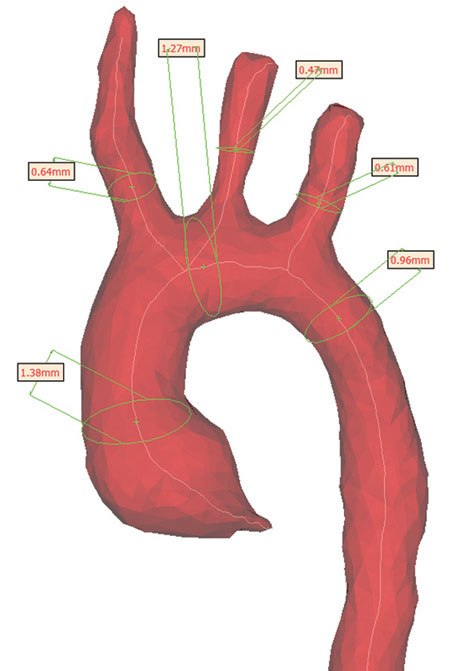Mice have become irreplaceable in cardiovascular research since they offer a representative, time-efficient model to study cardiovascular diseases such as aortic aneurysm, a local dilation of the aorta that takes decades to develop in humans. 3D computer models of the mouse aorta are usually created by vascular corrosion casting, which requires sacrificing the animals. In this case study, researchers from Ghent University compared these casts to 3D models obtained from live animals. In the future, these will allow follow-up studies to examine the process of aneurysm formation, ultimately benefitting clinical research. The wide range of tools in the Mimics Innovation Suite proved to be the perfect choice for several aspects in this research.

3D models of (l) in vivo scan, and (r) cast, from the same animal
Current Research Methodologies…
In order to study hemodynamics in the mouse aorta using Computational Fluid Dynamics (CFD) one needs a.o. 3D models of the mouse aorta, usually created by vascular corrosion casting. This technique consists in sacrificing the mice and retrograde injecting them in the abdominal aorta with a polymer. When sufficient injection resistance was obtained, the arterial tree was assumed to be fully perfused and the specimen was left to cure, hardening the polymer over time. The animal was then macerated in a KOH solution to dissolve all soft tissue, leaving only the polymerized arterial tree. This tree was resected and scanned in a micro-CT system, after which the images were converted into a 3D model using the Mimics Innovation Suite.

3D models of (l) in vivo scan, and (r) cast, from the same animal
… Versus in Vivo Micro-CT
As the vascular corrosion casting technique implies sacrificing the animals and thus excludes follow-up studies, the possibility to obtain this 3D model using in vivo microCT imaging was investigated. A lipid based iodine contrast agent was injected in the anesthetized animals to obtain sufficient image contrast between the arterial tree and the surrounding tissue. These mice were then scanned in vivo, after which the reconstructed datasets were analyzed by means of the Mimics Innovation Suite.
First, thresholding was applied to the data to form a rudimentary segmentation of the arterial tree surrounding the aortic arch. The researchers then manually edited this mask using the tools provided in the Mimics Innovation Suite, together with the different available morphological operators. Next, these masks, generated for different sections of the aortic arch, were combined. A 3D model was then generated based on this combined mask, and was fed to the Mimics Remesher to smoothen its surface and remove any unphysiological bulges. The outline of the smoothed model was compared to the original data to make sure that the diameter of the segmentation remained unchanged
“For our study, it was important to carry out qualitative and quantitative comparisons between 3D models and the Mimics Innovation Suite allowed us to do just that. Furthermore, it was easy to import our CT data and perform segmentations in order to generate accurate 3D models and meshes. The results were easily exported into other applications for further testing, such as CFD.”
- B. Vandeghinste

Comparison of Wall Shear Stress between (l) in vivo scan and (r) cast.
This set of operations was executed on four in vivo and ex vivo (through casting) datasets, each time of the same animals. This provided the researchers with ideal comparable 3D models. The bifurcation angles were compared by projecting all bifurcations onto one plane using the Sketcher functionality provided by 3-matic. These bifurcation angles showed a small angular difference between in and ex vivo measurements, primarily due to the different position between in vivo imaging and casting. The diameters of all bifurcations were measured using the midline calculations provided by the Medcad-module in the Mimics Innovation Suite. These differ 30% to 40% between in vivo and ex vivo measurements. This difference is large, but can be attributed to shrinkage of the ex vivo models due to polymerization effects, and vasodilatation in the in vivo models due to the injection of CT contrast agent.
Conclusion
The results show that contrast-enhanced micro-CT can be used to build reliable 3D models, based on in vivo data. The differences between the in and ex vivo models can be explained by shrinkage due to polymerization effects and dilatation due to the injected contrast agent. Our results show that vascular corrosion casting does not provide an accurate image of the aortic arch due to shrinkage, which also changes the angles of aortic arch branches, leading to an overall change in geometry. In-vivo imaging with a suited contrast agent provides an excellent alternative, even when follow-up studies are not needed.
Mimics® Innovation Awards
Acknowledging excellence in 'Engineering on Anatomy'
Use the Mimics Innovation Suite for your cutting-edge research
- Submit your case as a paper or poster
- Win up to 5,000 € if selected by the jury of international judges
- Be recognized in a press release, on the Materialise website, and in a case study
- Present your work at a Materialise event
If you would like more information or to enter the contest, go to: www.materialise.com/MIA
